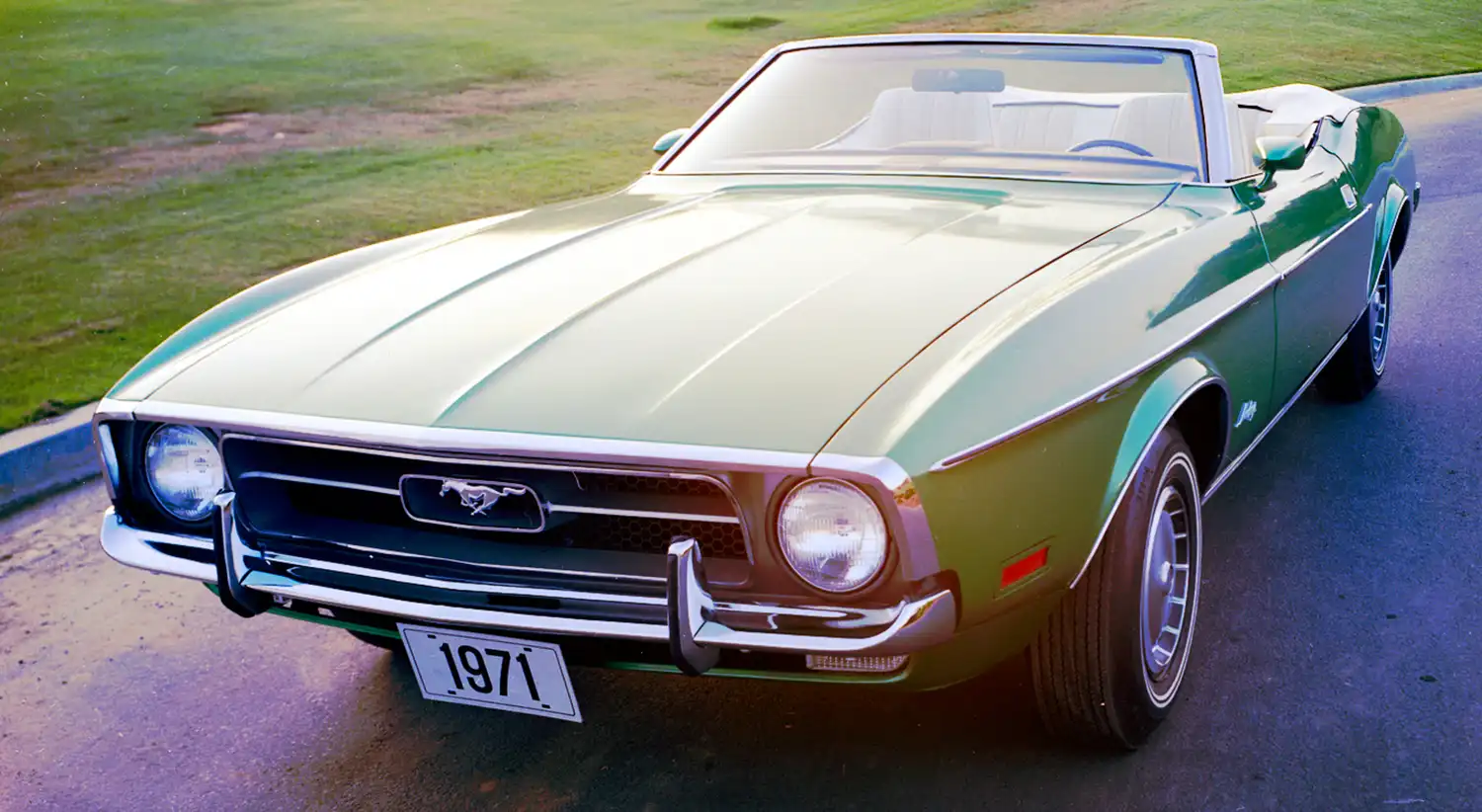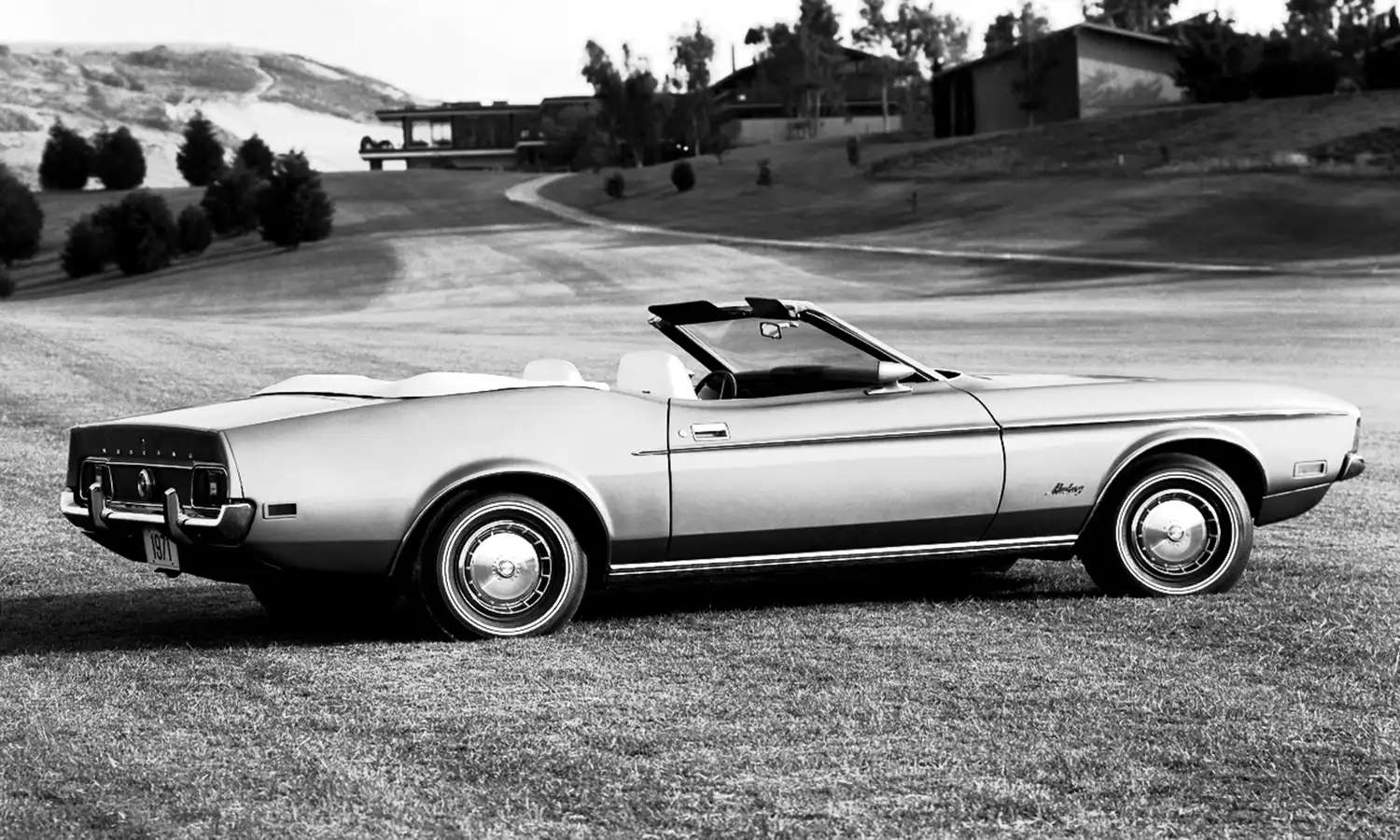
A New Dimension for the Mustang: The 1971 model year ushered in the first generation redesign for the Ford Mustang since its initial groundbreaking debut in 1964. This new iteration was notably larger than its predecessors, with a longer wheelbase, wider track, and increased overall dimensions. This growth was intended to accommodate Ford’s larger and more powerful engine options and to give the Mustang a more substantial presence in the evolving muscle car landscape. Despite the increase in size, the convertible version retained the open-top motoring experience that had always been a key part of the Mustang’s appeal. The 1971 Mustang Convertible, along with its coupe and fastback counterparts, represented a bold new direction for the beloved pony car, embracing a heavier, more aggressive styling that characterized the early 1970s automotive scene. This generation, often referred to as the “big Mustang,” lasted until 1973, making the 1971 model a significant part of this distinct era in Mustang history.
Exterior Styling: The 1971 Mustang Convertible showcased a dramatic departure from the sleek lines of the original Mustangs. The front end featured a prominent hood with dual headlights positioned within the grille, flanked by a bold bumper. The fenders flared more aggressively, contributing to the car’s wider and more muscular stance. The side profile was characterized by a longer hood and a shorter rear deck, a classic pony car proportion, albeit on a larger scale. The convertible top, when lowered, disappeared beneath a rear tonneau cover, providing a clean and streamlined appearance. The rear of the car featured horizontal taillights and a substantial bumper. Various trim levels, including the base model, Grande, Mach 1, and Boss 351, offered different exterior styling cues, such as hood scoops, racing stripes, and unique badging, further differentiating the convertible within the Mustang lineup. The overall design reflected the trends of the era, emphasizing a powerful and substantial look.

Interior Appointments: The interior of the 1971 Ford Mustang Convertible offered a blend of sporty styling and comfort. Depending on the trim level, upholstery options ranged from basic vinyl to more luxurious knitted vinyl or cloth. The dashboard featured a driver-centric layout with a prominent instrument cluster housing the speedometer, tachometer (in some models), and other essential gauges. The center console, available on many models, often housed the gear shifter and additional controls. Features such as air conditioning, power windows, and a variety of stereo systems were available as options, enhancing the driving experience. The convertible top was typically power-operated, providing convenience for open-air motoring. While the increased size of the 1971 Mustang provided a slightly roomier interior compared to earlier models, it still maintained a sporty and driver-focused feel. Different trim levels offered unique interior accents and materials, catering to a range of buyer preferences.
Engine Options and Performance: The 1971 Ford Mustang Convertible offered a wide array of engine options, catering to different performance desires and budgets. The base engine was usually a 250 cubic inch inline-six, providing adequate power for everyday driving. However, the more desirable options were the various V8 engines available. These included the 302 cubic inch V8, the 351 cubic inch “Cleveland” (351C) V8, and the potent 429 cubic inch Cobra Jet V8. The 429 Cobra Jet, with its Ram Air induction on some versions, was the top performance engine, delivering significant horsepower and torque for exhilarating acceleration and muscle car performance. Power outputs varied depending on the specific engine and options, but the larger V8s provided the Mustang Convertible with the muscle car credentials that many buyers sought. Transmission choices typically included a three-speed manual, a four-speed manual, and a three-speed automatic, allowing buyers to tailor the driving experience to their preferences. The performance figures for the V8-equipped convertibles were respectable for the era, offering strong acceleration and a thrilling open-top driving experience.

Convertible Top Mechanism: A key feature of the 1971 Ford Mustang Convertible was its power-operated convertible top. This allowed for easy and convenient transition between open-air cruising and a closed cabin. The top was typically made of durable vinyl and, when raised, provided reasonable protection from the elements. When lowered, it folded neatly beneath a color-keyed or black tonneau cover that gave the rear of the car a clean and finished look. The operation of the power top was usually controlled by a switch located on the dashboard, making it simple for the driver to enjoy the open road. The design of the convertible mechanism was generally reliable for the time, contributing to the overall enjoyment of the open-top Mustang experience.
Market Reception and Legacy: The 1971 Ford Mustang Convertible, while representing a significant change in size and styling, still found its share of buyers who appreciated the open-top motoring and the availability of powerful V8 engines. However, the “big Mustang” era, in general, is often viewed differently by enthusiasts compared to the leaner and more nimble first-generation models. Nonetheless, the 1971-1973 Mustangs have developed their own following over time, appreciated for their unique styling and the powerful engines that were available. The convertible version remains a desirable classic for those seeking open-air muscle car enjoyment from the early 1970s. Today, well-preserved examples of the 1971 Ford Mustang Convertible, especially those equipped with the larger V8 engines and desirable options, are sought after by collectors and enthusiasts who appreciate this distinct chapter in Mustang history.
Summary:
- The 1971 Ford Mustang Convertible was the first redesign of the original Mustang.
- It was larger than previous models, with a more muscular styling.
- Offered a range of engines, including powerful V8 options like the 429 Cobra Jet.
- Typically featured a power-operated convertible top with a tonneau cover.
- The interior offered various trim levels and available comfort features.
- Represented a shift in Mustang design towards a larger and heavier platform.
- Remains a collectible classic for enthusiasts of 1970s muscle cars.
Disclaimer: Information presented is for general knowledge. Accuracy can vary; verification is advised.
Source: Ford Heritage Vault
AI Assistance: Gemini
